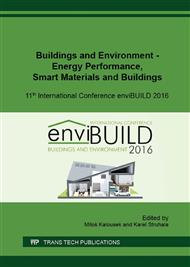p.151
p.160
p.167
p.175
p.183
p.190
p.198
p.206
p.213
Effect of Glazed Ratio on Indoor Comfort and Energy Need for Heating
Abstract:
According to the current national regulations appropriate operative temperature must be provided in premises. Nevertheless simplified calculation methods of heating built-in capacity and energy need for heating are based on indoor air temperature: to have the same output in function of operative temperature requires a series of iteration or dynamic simulation. Experience in existing buildings shows that higher glazed ratio is accompanied by decreasing Mean Radiant Temperature to be counterbalanced with higher indoor air temperature in order to keep the prescribed operative temperature. Nevertheless, in well insulated buildings this effect is weaker. Moreover, it turns into opposite: high Mean Radiant Temperature should be compensated with lower indoor air temperature which considerably decreases the heat loss – especially the ventilation heat loss. Energy need for heating of a sample building is analysed in the function of thermal insulation, glazed ratio and thermal mass.
Info:
Periodical:
Pages:
183-189
Citation:
Online since:
December 2016
Authors:
Keywords:
Price:
Сopyright:
© 2017 Trans Tech Publications Ltd. All Rights Reserved
Share:
Citation:


